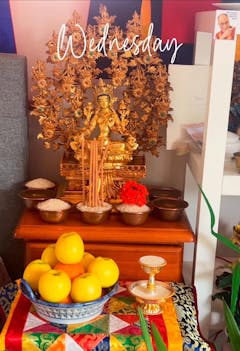Guhyasamaja Consort Statue | Spiritual Copper Sculpture from Nepal
Guhyasamaja Sculpture | Handcrafted Buddhist Tantra Statue
Guhyasamaja Statue for Vajrayana Devotees
Guhyasamaja Statue From Nepal | Encounter Divine Harmony
Guhyasamaja Statue | Handcrafted Buddhist Tantra Sculpture
Guhyasamaja Statue | Sacred Tantric Art from Nepal
Guhyasamaja Statue: Tibetan Buddhist
Guhyasamaja: The Embodiment of Tantric Transcendence
Tantric Deity Guhyasamaja Consort Statue | Handcrafted Buddhist Art
Nidhiratna’s Guhyasamaja Statue: Embodiment of Esoteric Wisdom
Nidhiratna's Guhyasamaja statue is a profound representation of the union of wisdom and compassion, embodying the esoteric teachings of Vajrayana Buddhism. Each statue is meticulously handcrafted in Nepal by master artisans, designed to reflect the intricate symbolism and sacred essence of Guhyasamaja, the “Secret Assembly.” Made with a copper base and gilded with gold, the statue’s radiant presence and exquisite detailing make it a stunning piece of spiritual art.
The statue captures Guhyasamaja in his divine embrace with consort Sparshavajra, symbolizing the union of method and wisdom—a key principle in tantric practices. The artist’s skill is evident in every delicate feature, from the serene expressions of the deities to the intricate ornamentation adorning their bodies. This level of craftsmanship reflects centuries of traditional artistry, passed down through generations, ensuring both spiritual authenticity and artistic mastery.
Beyond its artistic allure, the Guhyasamaja statue serves as a sacred tool for meditation and ritual, aiding practitioners in their journey toward enlightenment. It reminds devotees of the profound teachings of non-duality and the transcendence of worldly attachments.
Guhyasamaja: The Secret Assembly of Enlightenment
Guhyasamaja is one of the principal deities of the Vajrayana Buddhist tradition and is associated with profound tantric teachings. His name, meaning "Secret Assembly," refers to the esoteric practices that lead practitioners to realize the ultimate truth beyond dualistic concepts. Guhyasamaja represents the dharmakaya (truth body) of the Buddha, embodying the unity of all enlightened qualities.
In his form as Akshobhyavajra, Guhyasamaja appears in a tantric embrace with his consort, symbolizing the union of upaya (skillful means) and prajna (wisdom). This imagery emphasizes the inseparability of method and insight required to attain enlightenment.
Symbolism and Sacred Attributes
The intricate details of Guhyasamaja’s depiction carry deep spiritual significance:
- Multiple Heads and Arms: Represent his omniscience and the ability to manifest countless skillful means to guide sentient beings.
- Divine Consort: Symbolizes the union of wisdom and method, the essence of tantric realization.
-
Mudras (Hand Gestures): Convey teachings and blessings, with some hands holding sacred implements like the vajra and bell.
- The vajra represents compassion and indestructible resolve.
- The bell symbolizes wisdom and the emptiness of inherent existence.
- Lotus Throne: Reflects purity and detachment, highlighting the enlightened qualities that transcend the mundane world.
- Ornaments and Silks: Depict the six perfections—generosity, morality, patience, diligence, meditation, and wisdom.
Guhyasamaja’s calm yet powerful demeanor embodies the transformative energy of tantric practice, inspiring practitioners to embrace the path of inner realization.
The Practice and Mantra of Guhyasamaja
Practitioners engage with Guhyasamaja through visualization, mantra recitation, and rituals, aiming to dissolve the dualistic mind and attain the ultimate state of non-duality. His mantra is a sacred formula that invokes his blessings and aids in meditative absorption:
Om Sri Vajradhara Sarvatathagata Vajra Hum Phat
Each syllable in this mantra embodies the essence of the Vajrayana teachings:
- Om: Invokes the universal truth and purity.
- Sri Vajradhara: Addresses Guhyasamaja as the supreme holder of the vajra.
- Sarvatathagata: Refers to all enlightened beings and their qualities.
- Vajra: Symbolizes the indestructible nature of wisdom.
- Hum: Represents the union of method and wisdom.
- Phat: Dispels obstacles and negativity, clearing the path to enlightenment.
A Gateway to Enlightenment
The Guhyasamaja statue is more than a sacred artwork; it is a powerful symbol of transformation and liberation. For practitioners, it serves as a visual focus for meditative practices, fostering a deeper understanding of tantric teachings. Its profound imagery inspires devotion, reminding us of the infinite potential within to achieve enlightenment and transcend duality.


























































